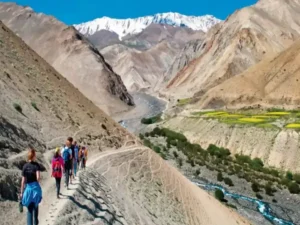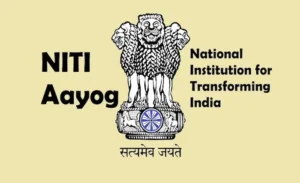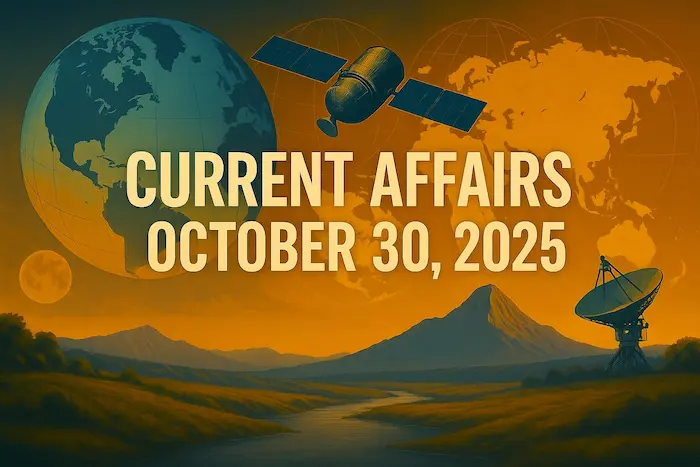1. Karakoram Wildlife Sanctuary – Proposal to Redefine Boundaries – Environment

Why in News?
The Central Government has recently received a proposal to redefine the boundaries and area of the Karakoram Wildlife Sanctuary, located in the Union Territory of Ladakh. This move underscores ongoing conservation efforts in one of India’s most ecologically sensitive and strategic regions.
About Karakoram Wildlife Sanctuary
Location & Geographical Context
Situated in Ladakh, bordering Jammu and Kashmir.
Lies north of Hemis National Park and east of Deosai National Park (Pakistan-administered Gilgit-Baltistan).
Forms part of the trans-Himalayan region, with strategic and ecological significance.
Topography & Terrain
Characterized by snow-covered peaks, alpine meadows, deep valleys, and rugged mountains.
Major peaks include:
Saltoro Kangri
Saser Kangri I
K12
Climate
Extreme cold temperatures, often below 0°C, especially in higher altitudes.
Snowfall and glacial conditions dominate the terrain.
Hydrology
Shyok and Nubra Rivers flow through the sanctuary, crucial for sustaining life in this arid mountain ecosystem.
Biodiversity Significance
Fauna (Wildlife)
The sanctuary is home to several endangered and rare species, including:
Snow Leopard
Tibetan Antelope (Chiru)
Siberian Ibex
Bharal (Blue Sheep)
Tibetan Gazelle
Ural
Argali
Bactrian Camel
Flora (Vegetation)
Rich in alpine and medicinal plant species.
Dominant plant types include:
Rosia webbiana
Ephedra
Caragana (broad-leaved shrubs)
Also supports endemic species and glacier vegetation that are specially adapted to cold, arid conditions.
Significance of Redefining Boundaries
The redefinition aims to:
Enhance protection and management of biodiversity.
Align boundaries with ecological and administrative needs.
Facilitate better conservation planning under changing climatic and geopolitical realities.
Important in the context of Ladakh’s fragile ecosystem and strategic location near the India-China border.
Exam Connect – Possible Questions
Prelims
1. Which of the following rivers flow through the Karakoram Wildlife Sanctuary?
A. Zanskar and Suru
B. Shyok and Nubra
C. Chenab and Ravi
D. Indus and Ganga
Answer: B. Shyok and Nubra
2. The Karakoram Wildlife Sanctuary is known for the natural habitat of which of the following species?
1.Snow Leopard
2.One-horned Rhinoceros
3.Tibetan Antelope
4.Bactrian Camel
Select the correct option:
A. 1, 2 and 3
B. 1, 3 and 4
C. 2 and 4 only
D. 1 and 2 only
Answer: B. 1, 3 and 4
Mains
1.Discuss the ecological and strategic significance of the Karakoram Wildlife Sanctuary. How will redefining its boundaries contribute to biodiversity conservation in the Trans-Himalayan region?
2.Examine the challenges faced in managing wildlife sanctuaries in high-altitude regions like Ladakh. Suggest policy measures to improve conservation efforts in such ecologically fragile zones.
2. Delhi Conducts Cloud-Seeding Trials to Tackle Toxic Air -Environment

Why in News?
In response to worsening air quality, the Delhi Government, in collaboration with IIT-Kanpur, conducted cloud-seeding trials to artificially induce rainfall and mitigate pollution. Despite minimal rainfall—0.1 mm in Noida and 0.2 mm in Greater Noida—the initiative marks a significant step toward exploring weather modification techniques for environmental management.
What is Cloud Seeding?
Cloud seeding is a weather modification technique designed to enhance precipitation by dispersing specific substances into clouds, thereby inducing rainfall.
How it Works
Involves injecting cloud condensation nuclei (CCN) or ice nuclei into clouds using:
Aircraft
Rockets
Drones
Common seeding agents include:
Silver Iodide (AgI)
Sodium Chloride (NaCl)
Potassium Iodide (KI)
Ideal Conditions for Successful Cloud Seeding
Cloud moisture/humidity above 50%
Cool temperatures
Existing cloud formations with sufficient vertical development
Delhi Trial Results & Challenges
Outcome: Minimal rainfall recorded (0.1–0.2 mm).
Reason for Limited Success:
Low cloud moisture levels (15–20%)
Lack of cloud depth due to weak western disturbances.
Despite low rainfall, air quality showed improvement, with reductions in PM2.5 and PM10 levels in parts of the NCR region.
Environmental and Scientific Concerns
Toxicity Risk: Use of silver iodide raises concerns about soil and water contamination.
Temporary Measure: Cloud seeding does not solve the root causes of pollution.
Dependence on Meteorological Conditions: Cannot be used reliably year-round.
Broader Context – Air Pollution in Delhi
Major contributors to Delhi’s air pollution:
Vehicle emissions
Construction dust
Crop stubble burning
Industrial emissions
While cloud seeding can offer short-term relief, experts stress the need for:
Structural reforms
Emission control strategies
Policy enforcement across sectors
Exam Connect – Possible Questions
Prelims
1. Which of the following is commonly used as a seeding agent in cloud seeding operations?
A. Ozone
B. Silver Iodide
C. Potassium Permanganate
D. Ammonia
Answer: B. Silver Iodide
2. Which of the following conditions is not essential for successful cloud seeding?
A. Presence of seed particles
B. Cloud moisture above 50%
C. High temperatures above
Answer: C. High temperatures above 45°C
Mains
1.Cloud seeding has emerged as a short-term intervention to combat air pollution. Critically evaluate its effectiveness and limitations in the context of urban air management strategies in India.
2.Discuss the scientific, ethical, and environmental implications of weather modification techniques such as cloud seeding. Should such interventions be mainstreamed in public policy for environmental management?
3. Understanding Cloud Seeding – A Scientific Approach to Air Quality Management – Environment

Why in News?
A Cessna 206H aircraft recently carried out a cloud seeding trial over Delhi, aimed at artificially inducing rainfall to combat the city’s increasing air pollution. This highlights the growing interest in geoengineering solutions for environmental challenges.
What is Cloud Seeding?
Cloud seeding is a weather modification technique designed to enhance precipitation (rain or snow) by artificially introducing substances that promote the condensation of water vapor in clouds.
How Cloud Seeding Works
Seeding Agents: Salts are released into clouds, acting as nuclei for water vapor to condense around.
Common agents:Silver Iodide (AgI)
Potassium Iodide (KI)
Sodium Chloride (NaCl)
Delivery Methods:
Aircraft (e.g., Cessna 206H)
Drones
Rockets or ground-based generators
Purpose:
Enhance rainfall in drought-prone regions
Improve air quality by settling airborne pollutants
Reduce hail damage or fog in certain sectors (e.g., aviation)
Meteorological Requirements for Cloud Seeding
For cloud seeding to be effective, specific atmospheric conditions are essential:
1. Adequate Moisture
Clouds must contain enough water vapor and liquid water.
Relative humidity ideally above 50%.
2. Cloud Characteristics
Clouds should have sufficient vertical depth—at least 1 km thick—to generate meaningful precipitation.
3. Favorable Wind Conditions
Winds should carry the seeding materials to the intended target area.
Excessive wind speeds may disperse or disrupt cloud formations.
4. Vertical Air Currents
Strong vertical updrafts help:
Spread the seeding material within the cloud
Promote sustained cloud development and droplet formation
Key Limitations
Effectiveness is conditional: Without ideal meteorological conditions, seeding is largely ineffective.
Temporary relief: Offers short-term benefits (e.g., for pollution control or drought) but does not solve root problems.
Environmental risks: Prolonged use of silver iodide may pose ecological and health hazards, though more research is needed.
Exam Connect – Possible Questions
Prelims
1. Which of the following is not commonly used as a cloud seeding agent?
A. Silver Iodide
B. Potassium Iodide
C. Sodium Chloride
D. Calcium Carbonate
Answer: D. Calcium Carbonate
2. What is the minimum vertical cloud thickness generally required for successful cloud seeding?
A. 100 meters
B. 500 meters
C. 1 kilometer
D. 2 kilometers
Answer: C. 1 kilometer
Mains
1.Discuss the science behind cloud seeding and its potential application in mitigating air pollution. Evaluate its viability as a long-term solution for urban environmental challenges.
2.What meteorological factors determine the success of cloud seeding? How can cloud seeding be integrated with broader climate resilience strategies in India?
4. Relief and Rehabilitation: Cyclones on India’s East Coast -Geography

Why in News?
A cyclone intensified over the Bay of Bengal between October 27–28, 2025, reviving concerns about India’s vulnerability to tropical cyclones, especially along the eastern coastline. Though less destructive than past events, it tested disaster preparedness and rehabilitation capacity in Andhra Pradesh and Odisha, bringing back memories of:
1977 Andhra Cyclone
1999 Odisha Super Cyclone
Both of which led to ~10,000 fatalities.
India’s Eastern Coastline and Cyclone Vulnerability
Geographical Factors
The funnel shape of the Bay of Bengal amplifies storm surges.
Warm sea surface temperatures (>26°C) make the region ideal for cyclogenesis.
Low-lying deltaic regions (like those of the Mahanadi and Godavari) increase the impact of storm surges and flooding.
States Most Affected
Odisha
Andhra Pradesh
West Bengal
Tamil Nadu
Historical Cyclone Impact
| Year | Cyclone Event | Estimated Fatalities |
|---|---|---|
| 1977 | Andhra Cyclone | ~10,000 |
| 1999 | Odisha Super Cyclone | ~10,000 |
| 2020 | Cyclone Amphan | ~100 |
| 2021 | Cyclone Yaas | Minimal due to better preparedness |
Despite modern technology, economic and livelihood losses remain substantial, particularly in agriculture and fisheries.
Progress in Disaster Preparedness
Institutional Mechanisms
Indian Meteorological Department (IMD): Provides timely cyclone forecasts and warnings.
National Disaster Response Force (NDRF): Specialized response units for disaster mitigation and evacuation.
State Disaster Management Authorities (SDMAs): State-level coordination.
Success in Recent Cyclone Response
~10,000 people evacuated in Andhra Pradesh during the recent cyclone.
Reduced fatalities reflect improvements in early warning systems, community response, and coordination.
Persistent Challenges
Infrastructure Vulnerability
Poorly constructed houses, roads, and power infrastructure in coastal areas are prone to:
Storm surge damage
Saltwater intrusion
Flooding
Livelihood Disruption
Fisherfolk, farmers, and informal sector workers are worst affected.
Loss of crops, boats, nets, and daily wages leads to prolonged recovery periods.
Rehabilitation Gaps
Relief efforts often focus on short-term needs (shelter, food).
Lack of long-term planning for:
Climate-resilient housing
Skill development
Psycho-social rehabilitation
The Way Forward: Climate-Resilient Coastal Development
To move from reactive relief to proactive resilience, India must focus on:
Early warning literacy in vulnerable communities.
Cyclone-resistant infrastructure (buildings, roads, shelters).
Livelihood diversification for coastal populations.
Ecosystem-based approaches (e.g., mangrove restoration for coastal defense).
Decentralized disaster governance with stronger community participation.
Exam Connect – Possible Questions
Prelims
1. The funnel shape of which of the following water bodies makes India’s east coast highly vulnerable to tropical cyclones?
A. Arabian Sea
B. Bay of Bengal
C. Gulf of Mannar
D. Indian Ocean
Answer: B. Bay of Bengal
2. Which of the following are key institutions involved in India’s cyclone disaster management?
1.National Green Tribunal
2.Indian Meteorological Department
3.National Disaster Response Force
4.Geological Survey of India
A. 1 and 4 only
B. 2 and 3 only
C. 1, 2 and 3 only
D. 2, 3 and 4 only
Answer: B. 2 and 3 only
Mains
1.Despite technological advancements in cyclone forecasting and response, India’s eastern coast continues to suffer from large-scale damage. Discuss the reasons for this and suggest measures for building cyclone-resilient coastal infrastructure.
2.Examine the evolution of disaster management policies in India in the context of recurring cyclones on the east coast. How can relief efforts transition into long-term climate-resilient rehabilitation?
5.NITI Aayog Report: Services Sector as a Key Growth Engine in India – Economy

Why in News?
Two new reports by NITI Aayog spotlight the increasing significance of India’s services sector, which now contributes:
55% to India’s Gross Value Added (GVA)
~30% of total employment
These figures underline the services sector’s central role in India’s economic transformation and its growing influence on employment and exports.
Key Highlights from the NITI Aayog Reports
Role in Economic Transformation
India’s economy is transitioning from agriculture to a knowledge and service-driven model.
The services sector has become the largest contributor to India’s GDP.
Global Standing
India is the 7th largest exporter of services globally.
It accounts for over 4% of global services exports.
Employment Trends
Employment Share Growth:
| Year | Share of Employment from Services |
|---|---|
| 2011–12 | 26.9% |
| 2023–24 | 29.7% |
Nearly 40 million jobs were created by the sector between 2017–18 and 2023–24.
Key Employment Drivers:
IT and ITeS
Financial services
Logistics
Professional services
Contribution to GDP and GVA
GVA Contribution:
49% in 2011–12 → 55% in 2023–24
Compound Annual Growth Rate (CAGR): ~7%
Shift from Traditional to Modern Services
Traditional services (e.g., retail, hospitality) growing slower than:
Digital services
Cloud computing
FinTech
AI-driven business services
Regional Disparities
Leading States:
Karnataka and Maharashtra: Advanced digital ecosystems, major IT hubs
Lagging Regions:
Bihar and Uttar Pradesh: Lower integration in high-value service chains
NITI Aayog’s Strategy: “Build – Embed – Scale”
1.Build: State-level service ecosystems through infrastructure & policy
2.Embed: Integrate MSMEs and informal sectors into service value chains
3.Scale: Use digital tools and skills to expand high-value service delivery
Policy Recommendations
Expand digital infrastructure and broadband connectivity
Invest in skill development, especially for Tier-2 and Tier-3 cities
Facilitate MSME integration into the service supply chain
Ensure regional equity by supporting lagging states
Promote sustainable and inclusive growth in the sector
Exam Connect – Possible Questions
Prelims
1. According to recent NITI Aayog reports, which sector currently contributes the most to India’s Gross Value Added (GVA)?
A. Agriculture
B. Manufacturing
C. Services
D. Construction
Answer: C. Services
2. What is India’s rank globally in terms of services exports, as per the NITI Aayog report?
A. 3rd
B. 5th
C. 7th
D. 9th
Answer: C. 7th
Mains
1.The service sector is increasingly becoming the backbone of India’s economic growth. Discuss the challenges and opportunities in ensuring inclusive and regionally balanced growth in the service economy.
2.Evaluate the “Build–Embed–Scale” framework proposed by NITI Aayog for enhancing the state-level service sector. How can it be instrumental in promoting employment and innovation in lagging regions?
6.Reimagining Indian Cities as Economic Growth Hubs for a Viksit Bharat – Economy

Why in News?
As India charts its path to becoming a $30 trillion economy by 2047 and aims to reach net-zero emissions by 2070, the role of urban centres has come under sharp focus. Cities must evolve into economic, sustainable, and resilient growth hubs, vital for realizing the vision of “Viksit Bharat” (Developed India).
The Central Role of Cities in Economic Transformation
Urban India: Key Facts
Urban areas contribute ~63% of India’s GDP (as per various economic surveys).
Expected to contribute ~75% by 2047 with proper policy and infrastructure investment.
Cities accommodate over 35% of India’s population (expected to cross 50% by 2047).
Why Cities Matter for a Viksit Bharat
1. Engines of Job Creation
Cities are hubs for:
Services sector
Manufacturing clusters
Start-ups and innovation ecosystems
Critical for absorbing India’s demographic dividend—young, urbanizing workforce.
2. Industrial and Infrastructure Development
Urban areas support:
Smart cities
Industrial corridors
Logistics parks
Offer scope for economies of scale, agglomeration benefits, and digital connectivity.
3. Sustainability and Climate Action
Cities are major emitters of GHGs, but also hold the key to:
Clean mobility
Green buildings
Urban afforestation
Waste-to-energy projects
Challenges Facing Indian Cities
| Area | Key Challenges |
|---|---|
| Infrastructure | Aging urban infrastructure, poor public transport |
| Housing | Shortage of affordable housing, urban slums |
| Governance | Weak urban local bodies, lack of fiscal autonomy |
| Environment | Air & water pollution, poor waste management |
| Inequality | Urban-rural divide, informal sector vulnerabilities |
The Way Forward – Transforming Urban Governance and Planning
Key Reform Measures
1.Urban Infrastructure Investment
Focus on Tier 2 and Tier 3 cities
Develop transit-oriented development (TOD) and smart mobility
2.Digital and Green Cities
Encourage digital infrastructure (e-governance, urban data platforms)
Promote climate-resilient urban design
3.Empowering Urban Local Bodies (ULBs)
Financial devolution, urban planning autonomy
Training and capacity building
4.Inclusive Urbanization
Promote affordable housing, livelihood security for urban poor
Integrate informal sector into formal economy
5.Public-Private Partnerships (PPPs)
Mobilize private sector for sustainable infrastructure projects
Urbanization & Sustainability: A Dual Mandate
India’s future cities must be:
Productive (economic hubs)
Liveable (quality of life, green spaces, affordable housing)
Sustainable (net-zero aligned, climate-resilient)
Digitally Integrated (smart governance)
Exam Connect – Possible Questions
Prelims
1. According to India’s long-term economic vision, by which year does the country aim to become a $30 trillion economy?
A. 2035
B. 2040
C. 2047
D. 2050
Answer: C. 2047
2. Which of the following are considered essential components of sustainable urban development?
1.Green buildings
2.Public transport systems
3.Waste-to-energy plants
4.Rural job schemes
A. 1, 2 and 3 only
B. 1 and 4 only
C. 2, 3 and 4 only
D. 1, 2, 3 and 4
Answer: A. 1, 2 and 3 only
Mains
1.Cities will play a pivotal role in India’s transition to a $30 trillion economy by 2047. Discuss the reforms needed in urban governance and planning to support this transformation.
2.Urbanization presents both an opportunity and a challenge for India. Evaluate how Indian cities can balance economic growth with environmental sustainability in the context of the net-zero goal by 2070.

